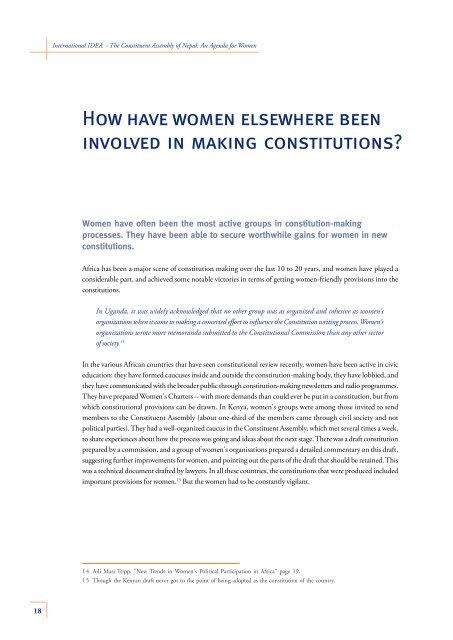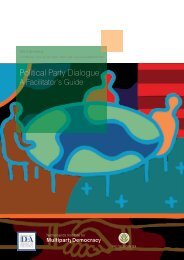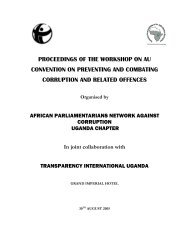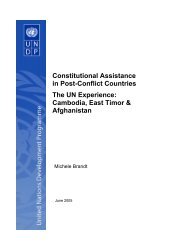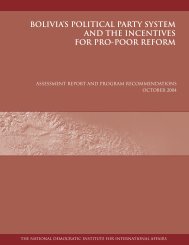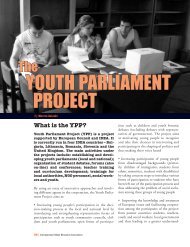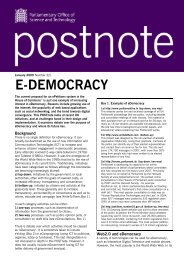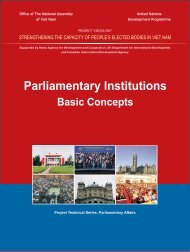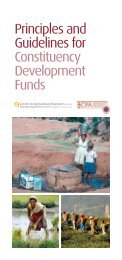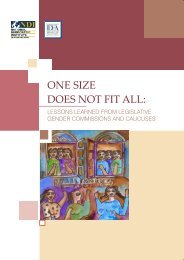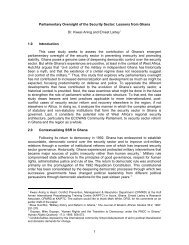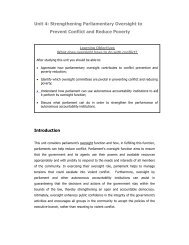The Constituent Assembly of Nepal: An Agenda for Women - CAPWIP
The Constituent Assembly of Nepal: An Agenda for Women - CAPWIP
The Constituent Assembly of Nepal: An Agenda for Women - CAPWIP
- No tags were found...
You also want an ePaper? Increase the reach of your titles
YUMPU automatically turns print PDFs into web optimized ePapers that Google loves.
International IDEA - <strong>The</strong> <strong>Constituent</strong> <strong>Assembly</strong> <strong>of</strong> <strong>Nepal</strong>: <strong>An</strong> <strong>Agenda</strong> <strong>for</strong> <strong>Women</strong>How have women elsewhere beeninvolved in making constitutions?<strong>Women</strong> have <strong>of</strong>ten been the most active groups in constitution-makingprocesses. <strong>The</strong>y have been able to secure worthwhile gains <strong>for</strong> women in newconstitutions.Africa has been a major scene <strong>of</strong> constitution making over the last 10 to 20 years, and women have played aconsiderable part, and achieved some notable victories in terms <strong>of</strong> getting women-friendly provisions into theconstitutions.In Uganda, it was widely acknowledged that no other group was as organized and cohesive as women'sorganizations when it came to making a concerted ef<strong>for</strong>t to influence the Constitution writing process. <strong>Women</strong>'sorganizations wrote more memoranda submitted to the Constitutional Commission than any other sector<strong>of</strong> society. 14In the various African countries that have seen constitutional review recently, women have been active in civiceducation: they have <strong>for</strong>med caucuses inside and outside the constitution-making body, they have lobbied, andthey have communicated with the broader public through constitution-making newsletters and radio programmes.<strong>The</strong>y have prepared <strong>Women</strong>'s Charters -- with more demands than could ever be put in a constitution, but fromwhich constitutional provisions can be drawn. In Kenya, women's groups were among those invited to sendmembers to the <strong>Constituent</strong> <strong>Assembly</strong> (about one-third <strong>of</strong> the members came through civil society and notpolitical parties). <strong>The</strong>y had a well-organized caucus in the <strong>Constituent</strong> <strong>Assembly</strong>, which met several times a week,to share experiences about how the process was going and ideas about the next stage. <strong>The</strong>re was a draft constitutionprepared by a commission, and a group <strong>of</strong> women's organisations prepared a detailed commentary on this draft,suggesting further improvements <strong>for</strong> women, and pointing out the parts <strong>of</strong> the draft that should be retained. Thiswas a technical document drafted by lawyers. In all these countries, the constitutions that were produced includedimportant provisions <strong>for</strong> women. 15 But the women had to be constantly vigilant.14 Aili Mari Tripp, "New Trends in <strong>Women</strong>'s Political Participation in Africa" page 19.15 Though the Kenyan draft never got to the point <strong>of</strong> being adopted as the constitution <strong>of</strong> the country.18


